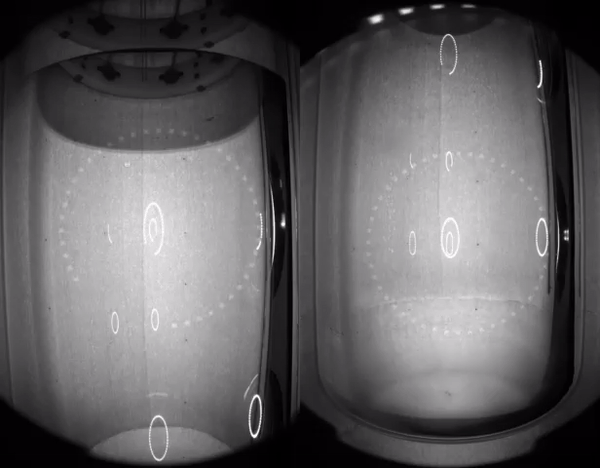Exhibits
Bubble Chambers
If you look back at the cloud chamber exhibit, we saw that particles could interact with the gas in the chamber and the trails left behind showed us when particles traversed through the chamber. The cloud trails, shapes, and sizes could then be used to visually determine what type of particle had passed through the chamber. A similar experiment can be done to see particle interactions, but rather than using cloud vapour, a different object is utilized: bubbles!
A bubble chamber is an apparatus that is full of a given liquid and kept at high pressure. When a particle passes through the chamber, it can create bubbles to be detected. Depending on the shape, size, and position of the bubbles, what type of particle travelled through the detector can be determined. Bubbles are also going to pop after a short time, and inside the detector we can capture the sound of the bubble’s creation and popping. The specific sound of the creation of the bubble forming is able to give scientists clues about the type of the particle detected, with each particle type giving slightly different sounds.

What is the liquid inside the detector and why must it be kept at a high pressure? How are the bubbles created?
Different liquids can be used to different effects determined by their properties in order to detect particles with the lowest background noise and cost. The liquid must be kept steady at a very precise pressure that puts it in a precarious state of wanting to boil, but just being shy of the energy required to do so. By carefully keeping the liquid in this balanced motionless state, the liquid is perfectly balanced between remaining calm liquid and beginning to boil into a vaporous state. When a particle like an alpha particle, or a neutrino coming from the sun, passes through the detector, it provides enough energy to the trail of liquid it passes through to cause it to boil. This then quickly releases a bubble (or a series of bubbles) that can be detected. The amount of bubbles produced, the relative size, and even the sound created when the bubble(s) form can then be used to figure out which type of particle it was that passed through the detector! Once the bubbles are formed, the device then quickly repressurizes itself to stop all the liquid from being disturbed and sets the device back to its state before the bubble was created, ready to detect again! The image to the right showcases a number of observed particle interactions passing through a chamber causing different bubble formations.
These detectors are currently being used in attempts to discover dark matter particles, as well as different types of neutrinos. Scientists are in labs right now developing new technologies with these chambers to try and discover a currently theoretical process called neutrinoless double-beta decay. You can check out a number of experiments currently using bubble chambers here as well as watch a YouTube video on the bubble chamber device used in the PICASSO experiment.
[expand title=”Teacher Resource – Curriculum Connections”]
Ontario Grade 9 Science (SNC1W)
Atomic models and particle classification :
C2.2 – research the role of experimental evidence in the development of various atomic models, and compare and contrast different models of the atom
The Sun as influencer :
E2.1 – describe the importance of the Sun and its characteristics, including its role in the solar system and in sustaining life on Earth
The Sun as particle producer :
E2.2 – explain how the Sun’s energy causes natural phenomena on Earth, and how these phenomena contribute to renewable energy production
Observable astronomical phenomena :
E2.6 – conduct investigations to explain the causes of various astronomical phenomena that can be observed from Earth
Ontario Grade 12 Physics (SPH4U)
Experimental inquiry :
D2.5 – conduct a laboratory inquiry or computer simulation to examine the behaviour of a particle in a field (e.g., test Coulomb’s law; replicate Millikan’s experiment or Rutherford’s scattering experiment; use a bubble or cloud chamber)
Standard Model of particle physics :
D3.1 – identify, and compare the properties of, fundamental forces that are associated with different theories and models of physics (e.g., the theory of general relativity and the standard model of particle physics)
Standard Model and particle types :
F3.4 – describe the standard model of elementary particles in terms of the characteristics of quarks, hadrons, and field particles
Ontario Grade 12 Earth and Space Science (SES4U)
Inquiry – cosmic rays and high-energy particles :
C2.3 – use an inquiry or research process to investigate the effects of various forms of radiation and high-energy particles on bodies, organisms, and devices within the solar system
Particle radiation and cosmic rays :
C3.9 – describe the major external processes and phenomena that affect life on Earth (e.g., radiation and particles from the “quiet” and “active” Sun; cosmic rays)
[/expand]
